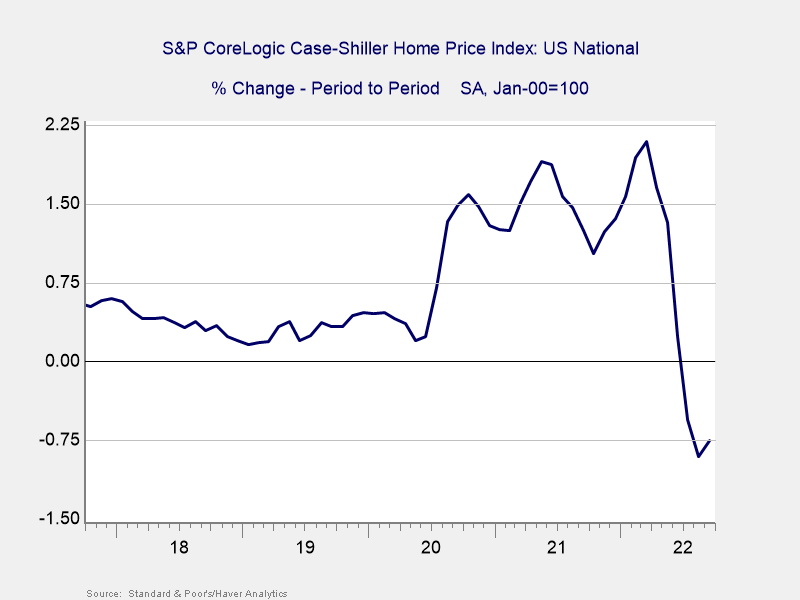Markets Rally in November
November saw market gains as all three major U.S. indices rose for the second consecutive month, with the S&P 500, Dow Jones Industrial Average (DJIA), and Nasdaq Composite returning 5.59 percent, 6.04 percent, and 4.51 percent, respectively. Equity markets were supported by rising optimism from investors that the Federal Reserve (Fed) is set to start slowing the pace of rate hikes.
These positive results were supported by solid fundamentals. Per Bloomberg Intelligence, as of November 23, 2022, with 96 percent of companies having reported actual earnings, the third-quarter blended earnings growth rate for the S&P 500 was 4.49 percent, up from estimates for 2.57 percent.
Technical factors were mostly supportive, with the S&P 500 and DJIA ending above their 200-day moving averages. This is the second straight month the DJIA finished above trend and the first time the S&P 500 ended a month above trend since March 2022. The Nasdaq finished below its 200-day moving average, as it has every month this year.
Developed and emerging market equities rallied in November. The MSCI EAFE Index gained 11.26 percent, marking two consecutive months with positive returns, and the MSCI Emerging Markets Index gained 14.85 percent. Both indices remained below their respective 200-day moving averages.
Fixed income markets had a positive month, driven by falling long-term interest rates. The 10-year U.S. Treasury yield dropped 4.07 percent to 3.68 percent. The fall in yields helped drive the Bloomberg U.S. Aggregate Bond index to a 3.68 percent return, and high-yield bonds were up. The Bloomberg U.S. High Yield Corporate Bond index gained 2.17 percent while high-yield credit spreads were largely unchanged.
Inflation Slows but Fed Remains Vigilant
We saw signs that the Fed’s efforts to combat rising prices are starting to succeed. Multiple Fed officials noted the central bank is exploring slowing the pace of rate hikes, highlighted by Fed Chair Jerome Powell’s comments regarding the Fed potentially hiking the federal funds rate 50 basis points (bps)—following four consecutive 75 bps rate hikes— at its December meeting. Markets reacted to the news positively, with equities staging a late-month rally.
Consumer and Business Spending Growth Improves
October’s job report showed 261,000 added jobs, well above 193,000 expected. While down from 319,000 jobs added in September, it represents a strong month of job growth and a healthy job market.
The strong labor market helped support consumer spending growth, with retail sales and personal spending showing solid improvements in October. The 1.3 percent increase in headline retail sales was the best result since February. Business spending showed signs of improvement. Durable goods orders increased 1 percent in October, above economist estimates for 0.4 percent. Core durable goods orders increased more than expected.
Housing Remains Soft
The housing sector showed signs of cooling in November. The pace of existing home sales fell to an annualized rate of 4.43 million in October—the lowest level since Covid-19 pandemic lockdowns in 2020—and well below the 2022 high of 6.49 million that we saw in January.
High mortgage rates, limited supply of homes for sale, and high prices served as headwinds for the housing sector, although we saw a modest decline in mortgage rates by month-end. Homebuilder confidence and new home construction showed signs of a slowdown. The housing sector slowdown also caused prices to start falling after rising throughout 2020 and 2021. As shown in Figure 1, September marked three consecutive months with declining house prices.
Figure 1. S&P CoreLogic Case-Shiller Home Price Index, Oct. 2017–Present

Positive Outlook Despite Risks
While November brought positive results, real risks remain. The fight against inflation isn’t over. The conclusion of midterm elections helped remove some political uncertainty, but a divided government could lead to political turbulence in the new year. The continuous Russian invasion of Ukraine is a constant source of uncertainty. The direct market impact of the war has largely faded, but an increase in hostilities could lead to instability. The slowdown in China should also be monitored.
The U.S. economy still shows signs of growth, with the strong job market and resilient consumer and business spending beating expectations. The most likely path ahead is for continued growth and market appreciation. Given the short-term uncertainty, a well-diversified portfolio that aligns with investment goals is the best path forward for most. As always, reach out to us if you have questions.
All information according to Bloomberg, unless stated otherwise.
Disclosure: Certain sections of this commentary contain forward-looking statements based on our reasonable expectations, estimates, projections, and assumptions. Forward-looking statements are not guarantees of future performance and involve certain risks and uncertainties, which are difficult to predict. Past performance is not indicative of future results. Diversification does not assure a profit or protect against loss in declining markets. All indices are unmanaged and investors cannot invest directly into an index. The Dow Jones Industrial Average is a price-weighted average of 30 actively traded blue-chip stocks. The S&P 500 Index is a broad-based measurement of changes in stock market conditions based on the average performance of 500 widely held common stocks. The Nasdaq Composite Index measures the performance of all issues listed in the Nasdaq Stock Market, except for rights, warrants, units, and convertible debentures. The MSCI EAFE Index is a float-adjusted market capitalization index designed to measure developed market equity performance, excluding the U.S. and Canada. The MSCI Emerging Markets Index is a market capitalization-weighted index composed of companies representative of the market structure of 26 emerging market countries in Europe, Latin America, and the Pacific Basin. It excludes closed markets and those shares in otherwise free markets that are not purchasable by foreigners. The Bloomberg Aggregate Bond Index is an unmanaged market value-weighted index representing securities that are SEC-registered, taxable, and dollar-denominated. It covers the U.S. investment-grade fixed-rate bond market, with index components for a combination of the Bloomberg government and corporate securities, mortgage-backed pass-through securities, and asset-backed securities. The Bloomberg U.S. Corporate High Yield Index covers the USD-denominated, non-investment-grade, fixed-rate, taxable corporate bond market. Securities are classified as high-yield if the middle rating of Moody’s, Fitch, and S&P is Ba1/BB+/BB+ or below. Authored by Brad McMillan, CFA®, CAIA, MAI, managing principal, chief investment officer, and Sam Millette, manager, fixed income, at Commonwealth Financial Network®. © 2022 Commonwealth Financial Network®





